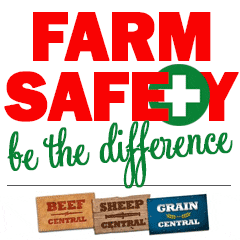IN MAY this year, a worker’s foot needed to be surgically amputated on site after coming into contact with three operating exposed augers at the bottom of a feeder bin trailer.
Early investigations by WorkCover Queensland indicate the worker was sitting on the edge of the feeder bin with both legs on the inside of the bin, using a shovel to remove excess feed stuck on the sides.
 For reasons yet to be established, he fell feet first into the feeder bin, trapping his legs within the three operating augers.
For reasons yet to be established, he fell feet first into the feeder bin, trapping his legs within the three operating augers.
To release him, his left foot had to be amputated and he sustained significant injuries to his right foot. Investigations are continuing.
Statistics
On average each year there are 38 accepted workers’ compensation claims for crush injuries involving machinery and fixed plant in the agricultural, forestry and fishing industries.
Fifty per cent of these are for serious injuries requiring five or more days off work.
Since 2013, WorkCover Queensland has notified of 48 incidents involving machinery and fixed plant injuries and have issued 536 statutory notices related to the risk of mobile or stationary plant within the agricultural, forestry and fishing industries.
Prosecutions and compliance
In 2015, a local government agency was fined $32,500 following an incident where a worker’s finger was amputated in the workplace.
Two workers were instructed to unblock the shaft of a screw auger at a sewerage treatment plant.
They had stopped the auger and removed the guard to remove the blockage.
However, the plant was restarted while the worker still had his hand in the auger, resulting in his finger being amputated.
In 2014, a company was fined $35,000 following an incident where a worker’s hand was amputated after it was drawn into a nut harvesting auger.
The worker was attempting to free a blockage with a stick, while the augers remained in operation.
The stick became caught, and the worker’s hand was pulled into the machine.
Preventing a similar incident
Plant is a major cause of workplace death and injury in Australian workplaces. There are significant risks associated with using plant and severe injuries can result from:
- its unsafe use
- exposure to unguarded moving parts of machines
- falls while accessing, operating or maintaining plant.
If the risks from plant cannot be designed out before it is installed, guarding, such as a shield, cover, or physical barrier, should be in place to prevent contact with moving parts.
There are four types of machine guarding:
- a permanently fixed guard, which is used if access to the area of plant requiring guarding is not necessary during operation, maintenance or cleaning
- an interlock guard, which is used if access to the areas requiring guarding is necessary during operation, maintenance or cleaning
- a fixed guard, which is used if it is not reasonably practicable to use a permanently fixed guard/barrier or an interlocked physical guard/barrier. Fixed guards can only be altered or removed using a tool
- a presence-sensing system/guard, which is used if it is not reasonably practicable to use a permanently fixed guard, an interlocked physical guard or a fixed guard in position.
If any type of guarding is removed for the purposes of maintenance or cleaning, it must be replaced before the plant is put back into normal operation. The plant should not be able to be restarted unless the guarding is in place.
Augers pose significant risks to workers when the moving parts are exposed. Hazards likely to cause injury include:
- driver belts, pulleys, chains, sprockets and drive shafts
- any rotating shafts (e.g. auger/screw flighting)
- any machine component which moves, cuts, pulps, crushes, breaks or pulverises materials.
Before cleaning or maintaining augers, you must follow isolation, lock-out and tag-out processes to avoid creating a hazardous situation. An isolation and lock-out process includes:
- de-energising or isolating the auger from all energy sources
- locking all the isolating units in the isolated position.
Source: WorkCover Queensland
More Information:
How to manage work health and safety risks Code of Practice 2011(PDF, 1048.03 KB)
Managing risks of plant in the workplace Code of Practice 2013(PDF, 1067.46 KB)
Rural plant Code of Practice 2004(PDF, 644 KB)

HAVE YOUR SAY